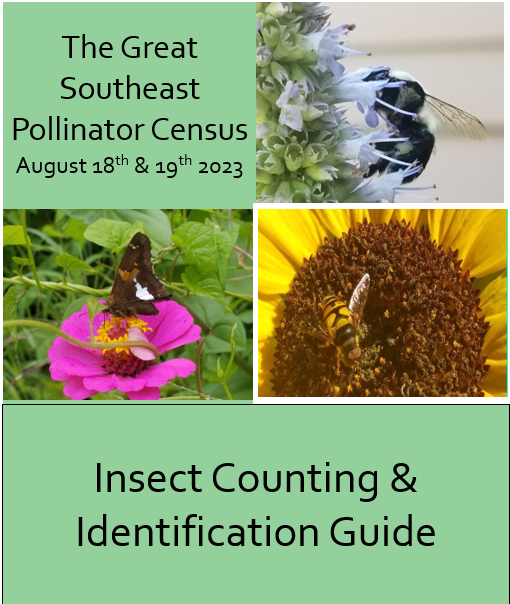Are you a fan of pollinators? Then, we need YOU! The Great Southeast Pollinator Census is your opportunity to provide valuable data on pollinator populations around our great state.
Every 3rd weekend in August, Georgians (and now South and North Carolinians, too) record the pollinators they see. UGA faculty use these data to compare changes in pollinator populations from year to year and county to county. This helps us make better informed decisions about how to manage and protect pollinators. All ages can participate (and have a ton of fun!).

On Saturday, August 24th, our Master Gardeners will be stationed at locations around Fulton County to help you complete your census count. They’ll even have giveaways and other fun pollinator-themed activities! While you’re there, stroll through our demonstration gardens. We’ve got native plants, cottage gardens, forest restoration sites, and more to spark your imagination and inspire your next gardening project.
Locations

GROWL GARDEN
9am – 3pm
Nestled on Herschel Road in College Park, the GROWL Garden is a community garden with raised beds planted with vegetables, herbs, and flowers. Maintained by passionate community gardeners, this garden showcases sustainable gardening in a shared space. Please respect the efforts of plot holders by not harvesting their produce.
4300 Herschel Rd.,
College Park, GA 30337

Island Ford Unit, Chattahoochee River National Recreation Area
10am – 2pm
Experience the rich biodiversity of Georgia’s native plants at the Chattahoochee National Recreation Area’s Island Ford Unit. At the entrance to the park, the Native Gardens greet you with a kaleidoscope of colors, attracting myriad pollinators. Continue on to the pollinator garden at the lodge to complete your census count.
8800 Roberts Dr.,
Sandy Springs, GA 30350

Fernwood Forest at Archibald Smith Plantation Home
10:30am – 1pm
Step back in time at the Archibald Smith Plantation in Roswell, where history and horticulture intertwine. As you tread lightly along marked trails, marvel at the delicate balance between conservation and cultivation, a testament to the ongoing efforts to preserve Georgia’s native plants.
935 Alpharetta St.,
Roswell, GA 30075

Cottage Garden at Lost Corner Preserve
9am – 11am
Transport yourself to a bygone era at the Lost Corner Nature Preserve on Brandon Mill Road in Sandy Springs. Wander through 24 wooded acres and discover the Cottage Garden, a tribute to heritage plants thriving in various light conditions. ADA-approved trails and picnic spots offer a perfect setting for a leisurely stroll or a tranquil picnic amidst nature’s splendor.
7300 Brandon Mill Rd. NW,
Sandy Springs, GA 30328

Summerour House at Autrey Mill Nature Preserve
10am – 12pm
Journey to Johns Creek and discover the Summerour House Garden at Autrey Mill Nature Preserve. Amidst three miles of wooded trails and captivating exhibits, immerse yourself in the charm of historic Georgia.
9770 Autrey Mill Rd.,
Johns Creek, GA 30022

Sandy Springs Farmers Market
8:30am – 12:30pm
Join Master Gardeners at our Little Diggers booth at the Sandy Springs Farmers Market. This is a one-stop shop for fun kids’ gardening activities! Master Gardeners will help you and your little ones learn all about the importance of pollinators.
1 Galambos Way,
Sandy Springs, GA 30328
Even if you can’t make it to one of our counting events, you can complete the Great Southeast Pollinator Census on your own anytime on August 23rd or 24th. Here’s what you do:
- Choose your favorite flowering plant.
- Set your timer for 15 minutes. Observe the flowers on your plant and record all pollinators that visit those flowers.
- Tally your observations by pollinator type: carpenter bees, bumble bees, honey bees, small bees, wasps, flies, butterflies/moths, and other.
- Upload your counts to the website: https://GSePC.org.
Watch the ‘How to Participate in the Great Georgia Pollinator Census’ YouTube video for a step-by-step tutorial!
It’s helpful to review the different pollinator categories ahead of time. Download the Insect Counting and Identification Guide from the GSePC website. Each pollinator category has descriptions, tips for identification, and photos. You’ll also want to download and print your Counting Sheet to use on census day. The counting sheet has handy descriptions of each pollinator category for easy reference. We also have Spanish language versions of GSePC materials!



It’s un-bee-lievable how much we can learn about our local pollinators just by slowing down and observing for 15 minutes. Grab your pencils, head outside, and get to know your polli-neighbors!